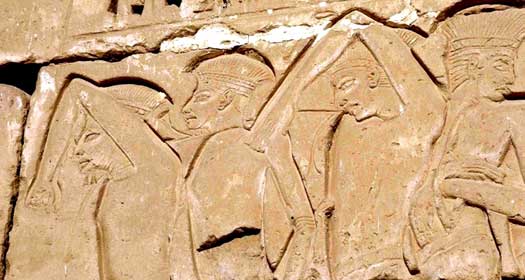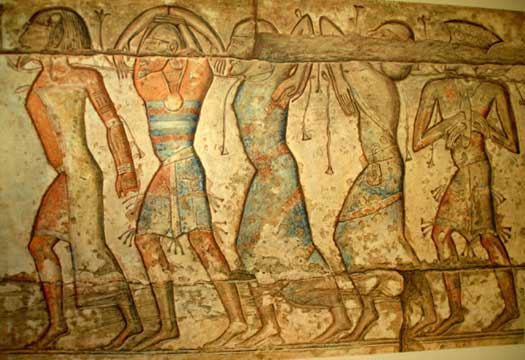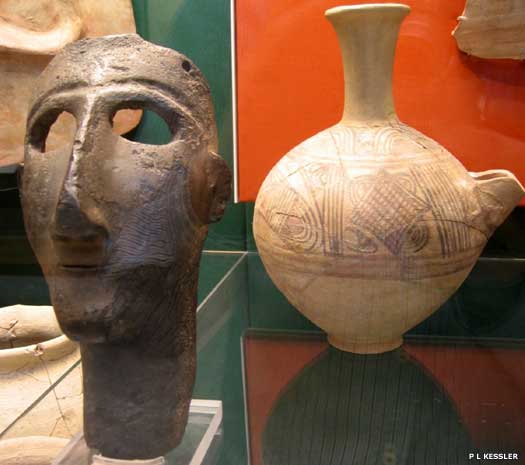
| SEA PEOPLES Towards the end of the thirteenth century BC, the international system started to break down. Characterised by international contacts between the empires of the Near East and their interaction with the many smaller states, especially in Syria and Canaan, the kings of Babylonia, Egypt, Elam, the Hittites, Mitanni, and in the later stages the Assyrians, maintained good lines of communication which opened up the ancient world, especially to trade. However, the system was one that made the elite very rich and the poor even poorer as their debts increased. Increasing numbers of people started to leave the cities to escape their debts, and often joined rogue groups known as the habiru in Syria and the Levant, which not only maintained a way of life free from the control of the major kings, but which also raided their cities and supplies.
The international system was starting to creak under the strain when it was also hit by drought and a loss of crops. Food supplies dwindled and the number of raids by habiru and other groups of peoples who had banded together greatly increased until, by about 1200 BC, this flood turned into a tidal wave which destroyed the Hittites and many Anatolia and Syrian cities and states, and brought about a dark age which delivered approximately two centuries of isolation to Egypt and the eastern states, Assyria, Babylonia, and Elam. It also isolated cities in Syria and the Levant, and saw the end of Mycenaean civilisation in Greece.
The term 'sea peoples' was used to collectively refer to this mass of raiding peoples and they frequently took everything with them on their attacks; wives, children, and belongings, and often settled in any territory they managed to conquer. The Bronze Age collapse they engendered brought the international system to an end, eventually to be replaced by one of great empires, but it didn't happen overnight. While its beginnings with the habiru were much earlier, it was only in about 1210 BC that things seriously started to go wrong, and the process of collapse lasted until about 1140 BC, with a recovery period which did not fully end until around 800 BC.
Judging by various contemporary accounts regarding the Sea Peoples, it seems the origin of many of them (if not all) was either in western Anatolia (from places probably including Ahhiyawa, and the Lukka, and perhaps Karkissa too), or mainland Greece (Mycenaeans escaping the Dorian invasion), or the islands in between. Killebrew states that it is noteworthy that the designation 'of the sea' appears only in relation to the Sherden, Shekelesh, and Eqwesh. Subsequently, this term was applied somewhat indiscriminately to several additional ethnonyms, including the Philistines, who are portrayed in their earliest appearance as invaders from the north during the reigns of the pharaohs Merenptah and Ramesses Ill.
(Additional information by Edward Dawson, from The Philistines and Other 'Sea Peoples' in Text and Archaeology, Ann E Killebrew (Society of Biblical Literature Archaeology and Biblical Studies, 2013), from Researches into the Physical History of Mankind, Vol 3, Issue 1, James Cowles Prichard, from The Roman History: From Romulus and the Foundation of Rome to the Reign of the Emperor Tiberius, Velleius Paterculus, J C Yardley, Anthony A Barrett, and from External Link: Listverse.)
c.1340 BC :
A member of the Shardana group of peoples is mentioned in the Armana letters.
c.1278 BC :
Ramses II repels a raid by the Shardana, taking prisoners.
c.1210 BC :
Drought in the region causes a famine and subsequent movement of peoples. Collectively known by chroniclers as the Sea Peoples, various groups begin raiding the Mediterranean coastline, attacking kingdoms and destroying cities, and in some cases even settling in the conquered areas. While not specifically Sea Peoples themselves, the Dorians have already begun invading Mycenaean Greece from the north, perhaps forced to move by those same drought conditions.
Attacks by the Sea Peoples gathered momentum during the last decade of the thirteenth century BC, quickly reaching a peak which lasted about forty years 1208 BC :
Egypt fights off an attempted invasion by a confederation of Libyan and northern peoples in the Western Delta. Raids on this area had already been so severe in recent years that the region was 'forsaken as pasturage for cattle, it was left waste from the time of the ancestors'. Included amongst the ethnic names of the repulsed invaders are the Danya, the Ekwesh, the Lukka, and the Tjekker.
c.1200 BC :
In Anatolia, Arzawa's old territory is destroyed, as is Hattusa, the capital of the Hittite empire, and Ishuwa, Kizzuwatna, and Tarhuntassa also fall. If the Ekwesh do originate from Ahhiyawa, their hostility towards the Hittites probably leads to their being involved in the destruction of that state.
In Syria and Canaan, various raids and attacks take place over a period of time. Alalakh, Amurru, and Hazor are all destroyed and Arvad is sacked. The group of Sea Peoples called the Peleshet grabs territory on the coast of the Levant in the region of Gaza.
The founding of Tabal in Anatolia is associated by some scholars with the Sea Peoples. Possibly some of their number settle in the region at this time.
c.1195 BC :
Ugarit is probably attacked by the Sea Peoples.
c.1185 BC :
Emar in Syria is destroyed, and large regions of Syria and Anatolia are left depopulated for many decades.
c.1182 BC :
Seven ships of Sea Peoples attack and destroy Ugarit, ending that state's existence, and on Cyprus Alashiya is sacked.
1179 BC :
Ramses III of Egypt records that he fights off an attack by Libyans and people from the north, almost certainly Sea Peoples. The Peleshet and the Tjekker are mentioned.
1176 BC :
Egypt fights another successful campaign against attackers from the north, this time against the Denyen, Peleshet, Shekelesh, Tjekker, and Weshesh. It seems the victorious Egyptians use their fleet to mount attacks on some of the bases used by their attackers.
1172 BC :
Ramses III records his final (believable) campaign against raiders who are identified as Sea Peoples, again the Denyen, Peleshet, Shekelesh, Tjekker, and Weshesh. Once again defeated by a surprise Egyptian attack, their power seems to wane and their threat appears to fade as they found new settlements on captured territory in the Levant and elsewhere.
c.1100 BC :
The Onomasticon of Amenemope document in Egypt appears to confirm that the former Sea Peoples, the Peleshet, Sherden, and Tjekker, are still settled in Philistia.
Danya / Dannuna / Denyen :
The Danya are mentioned in passing in the Armana letters from Egypt, in reference to the death of their king. The next time they appeared they were part of the combined force of Libyans and Sea Peoples which attacked Egypt in 1208 BC (as well as later). Once defeated and captured, they were subsequently settled along the coast of Palestine to help guard Egypt's 'way of the Philistines' between Egypt and Syria. They may be related to the Greek Danoi (another name for Homer's Achaeans in Mycenae), as well as to fairly recent settlers in Kizzuwatna, the Denyen. Those who are settled in Palestine are generally believed by scholars to be the Israelite tribe of Dan, which people are supposed to have settled with their ships in between Ekron and Joppa. The alternative is that they were forced inland by the newly arrived Philistines, which would explain their lack of any Israelite land to their name.
Ekwesh / Eqwesh / Akawasha :
The Ekwesh were part of the combined force of Libyans and Sea Peoples which attacked Egypt in 1208 BC. Some scholars see the Ekwesh as possible elements from Ahhiyawa, or even mainland Mycenaean Achaea. Homer and Odysseus mentioned an Achaean attack upon the delta, and later Greek myths stated that Helen spent the duration of the Trojan War in Egypt rather than Troy, and that after the war the Mycenaeans went there to recover her.
Doubt about the Mycenaean link comes from the prisoners taken by Egypt. To be sure of the numbers of enemy dead (6,000, with 9,000 prisoners), the pharaoh ordered that the penises of all the uncircumcised victims be cut off, along with the hands of those who had been circumcised. The Ekwesh number amongst the latter, making the Greek connection doubtful to some. However, the name 'Ekwesh' is very similar to the Indo-European word for horse. The related Latin word 'equa' is pronounced 'ekwa'. In this period Indo-Europeans were starting to lose their exclusivity when it came to using horses, but they still dominated the world's total number of horse users, and the Achaeans/Ahhiyawans were chariot users. Considering their own name, Ekwesh, clearly relating to the Indo-European word for horse, it can be seen that they were a division of Indo-Europeans, and almost certainly one that was related to the Achaeans (Greeks).
The group of people known as the Ekwesh were involved in the destruction of the Hittite kingdom around 1200 BC, although their origins are clouded in mystery Karkisa :
This was a minor grouping of Sea Peoples which were mentioned in passing by several sources. Their origins were in Anatolia, close to the Lukka, where they formed a tribal region known as Karkissa, or Caria to the later Greeks who began colonising the region from the twelfth century onwards.
Labu / Libu :
The Labu, or Libu, were one of many tribes of Libyans which were active around the thirteenth and twelfth centuries BC. Regarded as barbarians by Egypt, they frequently mounted raids large and small on Egyptian territory, and were often settled in groups as mercenaries by various pharaohs. It was the prominence of this particular tribe which caused its name to be adopted not only for what became modern Libya, but for the whole North African coast in the ancient world.
Lukka :
The Lukka were part of the combined force of Libyans and Sea Peoples which attacked Egypt in 1208 BC. They appear as only a small part of that force, however, and were more generally to be found as mercenaries in various first millennium armies, recruited from their home in southern Anatolia, where the confederation of uncultured and hard-fighting Lukka people had been identified by the Hittites.
Meshwesh :
The Meshwesh were an ancient Libyan tribe from the region of Cyrenica who were in an almost constant state of conflict with Egypt's Nineteenth and Twentieth dynasties. In 1208 BC and 1179 BC a large number of Libyans were joined by various Sea Peoples in attacks on Egypt. A further attack in 1176 BC was led largely by the Meshwesh, and when they were captured they were settled in Egypt and pressed into service. However, this did not stop further attacks from Libya. In fact, Meshwesh continued to prove problematical for Egypt for several centuries. By the eighth century BC they (or at least a division of them) were dominated by the Libu who formed their own city state within the Egyptian Nile Delta at Sais.
Peleshet :
The Peleshet were part of a combined force of Sea Peoples which attacked Egypt in 1179 and 1176 BC. The Egyptian scenes of the battles which took place show the Peleshet to be clean-shaven, wear a panelled kilt, a chest protector, and a circle of upright reeds or leather strips on their head. At around the same time they also grabbed territory for themselves on the coast of the Levant, and perhaps initially used this as a base for continued attacks on Egypt. The regional city of Gezer and others were destroyed around the same time. The new arrivals were known in the Old Testament as the Philistines.
Shardana / Sherden / Serden :
The Shardana were bold sea pirates who appear briefly in fragmentary records from the Bronze Age collapse but about whom very little is known. The costume they wear on reliefs looks similar to, but not the same as, that of the Peleshet, as well as bearing certain similarities to Mycenaean armour. They were sometimes employed as mercenaries, owing to their superior weaponry which could better withstand chariot attacks.
They were the earliest of the Sea Peoples to be mentioned, and until recently it was thought by their name and by archaeological finds that they migrated from Greece to Sardinia. Now it seems more likely that they originated on Sardinia and Corsica and migrated eastwards (and perhaps the Tyrsennoi with them). One of them was mentioned in the Armana letters from Egypt (roughly between the 1350s to 1330s BC), as an apparent renegade mercenary, while three more were slain by an Egyptian overseer. In the second year of the reign of Ramses II (1278 BC), the pharaoh repulsed a raid by the Shardana on the Nile Delta, and took Shardana prisoners. He also spoke of the continuing threat which these people posed to the Mediterranean coastline 'in their warships from the midst of the sea', so it is likely they played a notable (if unrecorded) part in the collapse.
Bronze mask dated between 1400-1150 BC probably depicting a Sherden warrior, although the horns are missing from the holes at the top of the head Shekelesh / Sheklesh / Shikala :
The Shekelesh were part of the combined force of Libyans and Sea Peoples which attacked Egypt in 1208 BC, and again in 1176 BC. They are also believed to be responsible for the destruction of Ugarit in 1182 BC. Another group of sea pirates, they apparently 'lived on ships', according to the Hittites in correspondence with Ugarit (letter RS 34.129). Egyptian scenes show that the Shekelesh prisoners had their hands removed (and were also circumcised) - these hands were then presented to the pharaoh as a count of the enemy. A Shekelesh prince is depicted wearing a beard and with a prominent, thin nose and a swept-back turban or hair style.
An interesting theory is that the Shekelesh were the Siculi of Sicily. Seemingly before they arrived on the island, the Siculi could have taken part in various Sea People raids and have their name recorded by the Egyptians. This seems possible when it is remembered that the Shekelesh were part of a combined force of Libyans and Sea Peoples, so there's no particular reason to count them purely as Libyans. The alternative form of the Siculi name, Sicel, could be another way of spelling Shekel, and the '-esh' could be a plural suffix that may have been of Egyptian origin. However, the use of circumcision was not an Indo-European practice, and the similarity in name may also be down to pure coincidence.
Tjekker :
The Tjekker were part of the combined force of Libyans and Sea Peoples which attacked Egypt in 1208 BC, and they returned in 1179 BC and 1176 BC. Once defeated and captured, they were subsequently settled along the coast of Palestine to help guard Egypt's 'way of the Philistines' between Egypt and Syria. They are thought by some scholars to be linked to the Anatolian Teucri, but another theory links them to Crete (Biblical Caphtor), which was heavily influenced by the Mycenaeans. They could later be found inhabiting some cities in northern Canaan, including Dor.
Tyrsennoi / Teresh / Tursha :
The Tyrsennoi were part of the combined force of Libyans and Sea Peoples which attacked Egypt in 1208 BC (under the name of the Teresh). It has been speculated that the Tyrsennoi could have originated from somewhere near the Tyrrhenian Sea (between Italy and Sardinia). The Greeks knew of them, and the name of that sea derives from a Greek term for Tyrsennoi. They may have borne some relation to the (possibly) Sardinian Shardana, while another theory is that they were related to the Etruscans (who called themselves 'Rasena'). Interestingly, the Elymi people of Iron Age Sicily have been linked to the Tyrsennoi. Reliefs in Egypt which show the Teresh depict them as being bearded, wearing pointed kilts, strips of leather or linen to protect their chests, and carrying either spears or a scimitar.
Weshesh :
The Weshesh were part of a combined force of Sea Peoples which attacked Egypt in 1176 BC. While their origins are unknown, some evidence points to Karkissa (Caria) as their possible homeland. Theory suggests that, like the Danya, they settled in Canaan and joined the Israelites as the tribe of Asher.
Source :
https://www.historyfiles.co.uk/ |


